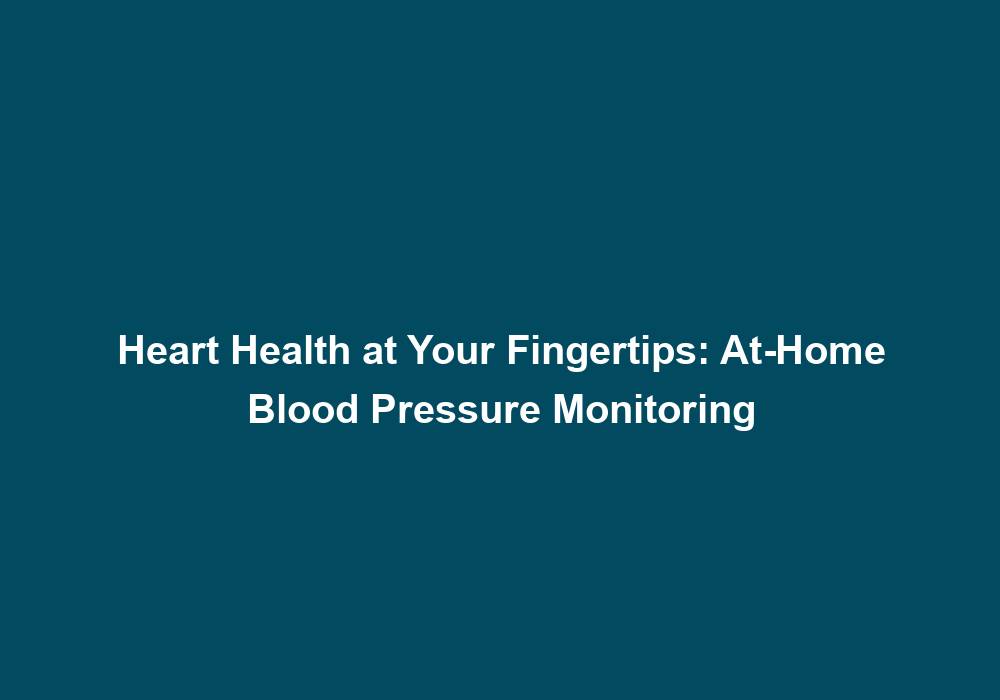Heart Health at Your Fingertips: At-Home Blood Pressure Monitoring
High blood pressure, also known as hypertension, is a common health condition that affects millions of people worldwide. If left untreated, it can lead to serious complications such as heart disease, stroke, and kidney damage. Monitoring your blood pressure regularly is crucial in maintaining good heart health and preventing these potential risks. In the past, monitoring blood pressure required a visit to a healthcare professional. However, with advancements in technology, at-home blood pressure monitoring has become more accessible and convenient. In this article, we will explore the benefits of at-home blood pressure monitoring and provide a guide on how to effectively monitor your blood pressure at home.
The Importance of Blood Pressure Monitoring
Blood pressure is the force exerted by the blood against the walls of the arteries as the heart pumps it around the body. It is measured in millimeters of mercury (mmHg) and is represented by two numbers – systolic pressure over diastolic pressure. The systolic pressure is the higher number and represents the pressure in the arteries when the heart beats, while the diastolic pressure is the lower number and represents the pressure when the heart is at rest between beats.
Monitoring blood pressure is essential for several reasons. Firstly, it allows individuals to identify any potential fluctuations or abnormalities in their blood pressure levels. Regular monitoring helps in early detection of hypertension, enabling individuals to take timely measures to lower their blood pressure and reduce the risk of associated health complications. By monitoring blood pressure regularly, individuals can be more proactive about their heart health.
Secondly, blood pressure monitoring is crucial for people who have already been diagnosed with hypertension. It helps them track their progress and evaluate the effectiveness of their treatment plan. By monitoring their blood pressure at home, individuals can gain a better understanding of how their lifestyle choices and medication are impacting their blood pressure levels. This information can be shared with healthcare professionals, allowing them to make informed decisions regarding medication adjustments or other necessary interventions.
Lastly, monitoring blood pressure can also provide valuable information to healthcare professionals, allowing them to make informed decisions regarding medication adjustments or other necessary interventions. By regularly monitoring their blood pressure at home, individuals can provide their healthcare providers with a comprehensive view of their blood pressure patterns over time. This data can help healthcare professionals make more accurate diagnoses and treatment plans.
Advantages of At-Home Blood Pressure Monitoring
Traditionally, blood pressure monitoring was primarily done in clinical settings like hospitals or doctor’s offices. However, at-home blood pressure monitoring has gained popularity due to its numerous advantages. Here are some key benefits of monitoring your blood pressure at home:
-
Convenience: At-home blood pressure monitoring eliminates the need for frequent visits to healthcare facilities, saving time and reducing the inconvenience of scheduling appointments. With an at-home blood pressure monitor, you can monitor your blood pressure whenever it is most convenient for you, ensuring regular monitoring without disrupting your daily routine. This convenience encourages individuals to be more consistent with their blood pressure monitoring, leading to better management of their heart health.
-
Comfort: Some individuals may experience white coat syndrome, where their blood pressure readings are higher in a clinical setting due to anxiety or stress. Monitoring blood pressure at home provides a more relaxed and comfortable environment, resulting in more accurate readings. By taking blood pressure measurements in a familiar and comfortable setting, individuals can obtain more reliable and representative readings of their blood pressure levels. This helps healthcare professionals make more accurate diagnoses and treatment decisions.
-
Cost-effective: Over time, regular visits to healthcare facilities for blood pressure monitoring can become costly. At-home blood pressure monitors offer a one-time investment that can be used repeatedly, reducing the long-term financial burden. By investing in an at-home blood pressure monitor, individuals can save money in the long run while still effectively managing their blood pressure levels. This cost-effectiveness makes at-home blood pressure monitoring a practical choice for many individuals.
-
Personalized Data: At-home blood pressure monitoring allows individuals to track their blood pressure readings over an extended period, providing a comprehensive view of their blood pressure patterns. This data can be shared with healthcare providers, enabling better personalized care and treatment adjustments if necessary. By regularly monitoring their blood pressure at home, individuals can provide their healthcare providers with more accurate and detailed information about their blood pressure trends. This helps healthcare providers tailor treatment plans to the individual’s specific needs, leading to more effective management of hypertension.
How to Monitor Your Blood Pressure at Home
To effectively monitor your blood pressure at home, follow these guidelines:
-
Choose a Reliable Blood Pressure Monitor: Invest in a digital blood pressure monitor that is validated for accuracy. Look for monitors that have been tested and approved by regulatory authorities, such as the US Food and Drug Administration (FDA) or the British Hypertension Society (BHS). A reliable blood pressure monitor ensures accurate measurements and provides reliable data for monitoring your blood pressure.
-
Prepare for Measurement: Before taking your blood pressure, ensure you are in a calm and quiet environment. Avoid smoking, consuming caffeine, or exercising at least 30 minutes before measurement, as these factors can temporarily increase blood pressure. Creating a calm environment helps ensure more accurate and consistent blood pressure readings.
-
Proper Cuff Placement: Place the cuff on your upper arm, following the manufacturer’s instructions. It should be snug but not too tight. The cuff should be positioned at heart level for accurate readings. Proper cuff placement is crucial for obtaining accurate blood pressure measurements. Follow the instructions provided with your blood pressure monitor to ensure correct cuff placement.
-
Sit Correctly: Sit in a chair with your feet flat on the floor and your back supported. Rest your arm on a table or armrest, ensuring it is relaxed and supported at heart level. Maintaining the proper sitting position helps ensure accurate blood pressure measurements. Proper positioning reduces the likelihood of false readings due to poor posture.
-
Take Multiple Measurements: It is recommended to take two or three readings, spaced a few minutes apart, to ensure accuracy. Blood pressure can fluctuate throughout the day, so taking multiple measurements provides a more representative picture of your blood pressure levels. Record the measurements, along with the date and time, for reference and tracking purposes.
-
Keep a Blood Pressure Log: Maintain a log or use a smartphone app to record your blood pressure readings regularly. This will help you track your progress over time and provide valuable information to your healthcare provider. Keeping a blood pressure log allows you to monitor trends and identify any significant changes in your blood pressure readings. It also helps your healthcare provider make informed decisions regarding your treatment plan.
-
Share the Data with Your Healthcare Provider: During routine check-ups or appointments, share your blood pressure log with your healthcare provider. They can assess the data and make necessary adjustments to your treatment plan if required. Sharing your blood pressure log with your healthcare provider allows them to have a more comprehensive understanding of your blood pressure patterns. This information helps them make informed decisions about your treatment plan and any necessary adjustments.
Conclusion
At-home blood pressure monitoring is an effective and convenient way to keep track of your blood pressure levels and maintain good heart health. By monitoring your blood pressure regularly, you can detect any abnormalities early on and take appropriate measures to prevent complications. With the advancements in technology, reliable blood pressure monitors are easily accessible, allowing individuals to monitor their blood pressure at their own convenience. Remember to choose a validated blood pressure monitor, follow the proper measurement techniques, and keep a record of your readings. By actively monitoring your blood pressure at home, you can play an active role in managing your heart health and overall well-being. Regular blood pressure monitoring empowers individuals to take control of their health and make informed decisions about their lifestyle and treatment options. Start monitoring your blood pressure at home today for a healthier tomorrow.
This response has been generated by an AI language model and may not fully meet your requirements as a native English speaker.







